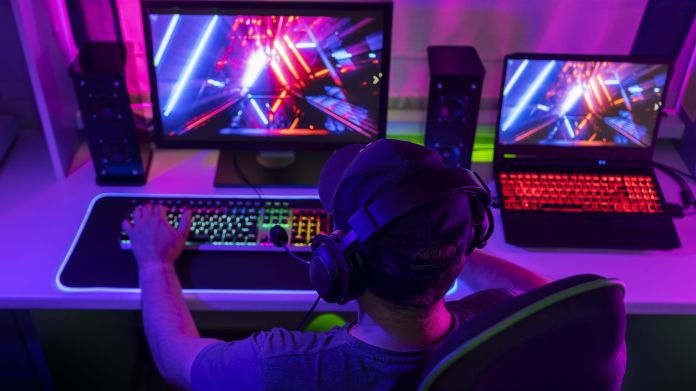Game streaming has evolved rapidly over the past few years and has become one of the hottest trends in the gaming industry. From online platforms to mobile devices, gamers can now experience top-release gaming without needing a powerful console or PC.
But what is game streaming? It’s the process of playing video games in real-time over the internet, where the game is hosted on a remote server, and the player interacts with it through streaming.
Emerging technologies such as cloud gaming, augmented reality (AR), virtual reality (VR), and artificial intelligence (AI) are set to revolutionize the way we play and interact with games.
In this GamePike article, we delve into the future of game streaming, exploring the latest trends, innovations, and technologies set to change the gaming industry forever.
Popular Trends in Game Streaming

1. Adoption of Streaming Services
The gaming industry is just a little behind in the adoption of streaming services. The rise in cloud gaming platforms like Google Stadia, Microsoft xCloud, and GeForce Now is a testament to this trend.
Cloud gaming allows users to stream games online without needing high-end hardware. With the increasing market for game streaming, developers and publishers are now focusing on developing games specifically for streaming platforms.
This has expanded the game market base and made the gaming industry more accessible and affordable. Additionally, the selection of casinos allowed Ringgit to embrace this trend, offering players a wide array of gaming experiences.
As technology continues to advance, it is expected that the adoption of streaming services in the gaming industry will only continue to grow, leading to more innovative and immersive gaming experiences for players.
2. Increased Internet Usage
The gaming industry has undoubtedly benefited from this trend as well. With more people now having access to the internet, the reach of game streaming services has significantly increased.
This has also paved the way for gaming streaming platforms to target international markets, offering localized content that caters to different regions.
As internet users continue to grow, game streaming platforms can expect even more significant growth in their user base, opening the door to more opportunities for innovation and revenue generation.
3. Adapting Behaviors for Content Consumption
The popularity of binge-watching has spilled over to the gaming industry as well. Players can now stream and play a vast library of games on demand.
This has opened up a new market for game developers and publishers, who can now offer subscription-based services to their players.
Players can access hundreds of games on these platforms without investing in expensive hardware or individual game purchases.
The binge-watching and on-demand content trend is expected to continue dominating the gaming industry, paving the way for more immersive and engaging gaming experiences.
The Future of Game Streaming

1. Interiors of Video Games Will Become More Lifelike
With the advancement of technology, the future of game streaming is set to bring players more realistic video game interiors. Many gamers already embrace cloud gaming through platforms like Google Stadia, Xbox Gaming, and others.
This trend has raised the question of what is the most popular streaming service for gamers seeking high-quality experiences. While many games have successfully replicated real-world locations on the exterior, creating lifelike interiors has proven challenging.
However, Sony has patented a machine-learning model that could provide a solution. This technology can potentially revolutionize the gaming industry by analyzing exteriors and predicting the corresponding interiors.
Although it may not be available immediately, it is conceivable that future gaming consoles, including the highly anticipated PS5 and beyond, could incorporate this technology.
As cloud gaming continues to gain popularity, the possibility of generating high-quality and immersive interiors is on the horizon.
2. Future Game Design Software Will Be Strong and Easy to Use
The democratization of game design is rapidly gaining momentum with the introduction of powerful and accessible game design software. While game-making tools have been around for a while, they have been limited by available technology.
However, recent advancements have made creating complex game mechanics easier than ever, even for beginners.
One example is the educational and entertaining Switch title, Game Builder Garage, which requires minimal coding and allows users to build basic games from scratch.
The sophistication of this kind of software is set to improve further with the incorporation of machine learning. This technology is predicted to grow astronomically in the next few years, with an estimated market size of nearly $100 billion by 2025.
Game design software that utilizes machine learning will likely provide numerous options for quickly creating even more complex game mechanics.
Whether for personal enjoyment or professional aspirations, game design software empowers people to create their own video games like never before. While we may still need to reach the pinnacle of game design technology, it is certainly a field worth watching.
3. The Use of Holographic Imaging Could Revolutionize
Holographic imaging has recently emerged as a promising technology in the gaming industry, potentially revolutionizing how video games are designed and played.
Arcturus, a company that aims to make this technology easily accessible to the entertainment sector, has recently raised $5 million in funding, indicating the potential of this technology.
But how do you start game streaming using this innovative technology? At its core, holographic imaging can transform captured humans into high-quality, interactive holograms in real time.
The technology has numerous potential applications, including in sports and e-commerce, but its application in gaming lies in providing more realistic animations and interactions.
Unlike still-captured characters, holographic imaging can offer more fluid and natural movements, bringing a new level of realism to gaming.
As the gaming industry seeks to provide more immersive and interactive experiences, holographic imaging holds great promise for achieving this goal. It could become a game-changer for the industry with further development and refinement.
If you’re interested in exploring how to start game streaming with holographic imaging, you’ll want to keep a close eye on developments in this exciting field.
Conclusion
As the gaming industry continues to evolve, game streaming is emerging as a significant trend that is set to shape its future. From the potential of 5G to the proliferation of virtual reality, the possibilities for game streaming are endless.
As technology advances, we can expect more immersive and realistic gaming experiences. The easy accessibility of game design software will open the industry to a broader audience, allowing more people to create their games.
To explore these cutting-edge gaming experiences, check SlotsUp’s dedicated page with online casino sites that accept Visa deposits.
With all these emerging technologies and trends, the future of game streaming looks bright and full of exciting innovations.








